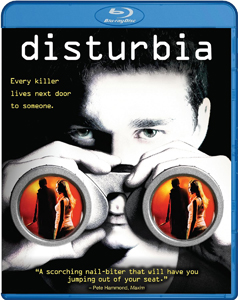After the Christopher Reeve “Rear Window” (1998) dug into the daily life of a quadriplegic, the 1954 Hitchcock classic further showed its flexibility as a template with 2007’s “Disturbia.” In some ways, it’s just another teen horror film, but even young viewers who didn’t know it was a “Rear Window” remake probably sensed an unusual veneer of class behind this project amid the Naughties horror decade.
That residually comes from Hitchcock’s film, although director D.J. Caruso does have a solid sense of suspense, the suburban block is evocative and cinematographer Rogier Stoffers uses darks and lights — and indoors and outdoors — to build mood.
Shia LaBeouf had started to carve out his niche as a millennial teen with an old-fashioned actorly quality, and he’s a likeable centerpiece despite being named Kale and being under house arrest for punching a teacher. The backstory shows he’s as in the right as someone can be when punching another person.

“Disturbia” (2007)
Director: D.J. Caruso
Writers: Christopher Landon (screenplay, story), Carl Ellsworth (screenplay)
Stars: Shia LaBeouf, David Morse, Carrie-Anne Moss
Stir in quirky bestie Ronnie (Aaron Yoo) and hottie girl next door Ashley (Sarah Roemer) and the Quikrete is laid for a fun movie as Kale – like Jimmy Stewart and Reeve before him – starts to believe his neighbor (David Morse’s Mr. Turner) is a killer.
Spying is wrong … but who cares?
A fun movie, but not quite a great movie. Writers Christopher Landon and Carl Ellsworth tap into talking points about paranoia, voyeurism and neighborly connections (or lack thereof) but skirt around strong statements. At one point they make an eye-rolling statement.
Ashley says Kale is either creepy or sweet for spying on her so aggressively that he has gotten into her mind. She settles on sweet, but – sorry if this is politically incorrect to say – that’s only because she likes him. If she disliked him, the same action would be creepy.
This shouldn’t really be the gray area “Disturbia” wants it to be: It’s always morally wrong to spy on someone with binoculars when they are in the privacy of their own home. If a person is outdoors – like when Ashely uses her swimming pool and (in a comedic gag) Kale and Ronnie pull out the binoculars even though they know it’s wrong – that’s more of a gray area. And if they are in public, the object of viewing is fair game.
Setting aside the morality of being a looky-loo, Kale should be concerned about his psychological state as he spies on other people rather than living his life. Granted, his mom (Carrie-Anne Moss, wasted by the screenplay) has canceled his iTunes and Xbox accounts and literally cut the cord on his bedroom’s TV.

But “Disturbia” is more interested in plot than character. It visually and spatially expands on “Rear Window” in neat ways, as Kale looks out of every window of his house, not confining himself to a single tableau. He dispatches Ronnie and Ashley around town to investigate Mr. Turner. In one strong sequence that utilizes cellphone recording and sending technology in a way the 1954 film couldn’t, Ashley is watching Turner and reporting to Kale, who is then reporting to Ronnie, who is probing Turner’s property.
How it might have gone
(SPOILERS FOLLOW.)
Although lip service is given to the idea that Kale’s suspicions might be wrong (as with the “Rear Window” voyeurs), he’s actually right all along. I felt there was about a 5 percent chance Mr. Turner isn’t the killer, but if “Disturbia” had cashed in on that 5 percent it might have been elevated from good to great.
We’re overdue for a “Rear Window”-type film that actually takes the voyeur to task for his actions, rather than concluding “Well, in this case it’s OK, because you turned out to be right.” It would’ve fit well in the post-9/11 era of mass paranoia to remind us that suspicion of everyone you meet is unhealthy.
When Mr. Turner commits a violent act on screen for the first time – thus ending the mystery (if there ever was one) – we’re propelled into a grand finale that’s technically well shot. But the only question is “Who will survive – and how?” Any nuance has been stripped away. Although it’s true that the 1954 “Rear Window” props up a voyeur as a hero, there’s a fascinating layer to the final showdown because Raymond Burr is flabbergasted as to why Stewart has been spying on him.
In “Disturbia,” I’m more likely to ask why in the world Mr. Turner – living in Aughts paranoid suburbia rather than “mind your own business” midcentury New York — saws up a deer in a room where blood can splash against the window for neighbors to see and hear. The answer is because “Disturbia” – for all its positive traits — is ultimately more of a straight-ahead thriller than a mystery about human behavior, or even who done it.
RFMC’s Alfred Hitchcock series reviews works by the Master of Suspense, plus remakes and source material. Click here to visit our Hitchcock Zone.

